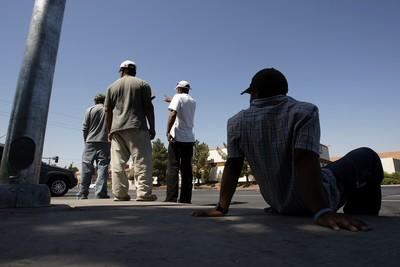WORKING IN SHADOWS


Immigrants seeking a better life in the United States historically have been greeted with suspicion, if not outright hostility.
The Irish, Italians, Jews and others all took turns as the proverbial boogeyman. They evoked fear and prejudice and were blamed for society’s ailments.
"Whenever new immigrants are compared and are told they are different from the last group of immigrants, well, that last group of immigrants was treated pretty much the same way," said David Thronson, an associate law professor at the University of Nevada, Las Vegas and adviser at the school’s immigration clinic.
"They were equally ostracized and seen as outsiders. They were pushed to the side, at the time. And now, we look back on them with nostalgia and say, ‘If only our current immigrants could be like that group that came over before.’"
Incurring much of the nation’s wrath nowadays are 12 million people who have entered the country illegally, mostly from Mexico.
And besides being branded "illegal," what distinguishes them from their predecessors, some say, is that many are brown-skinned.
The 12 million, including an estimated 7.2 million "undocumented workers" in the labor force, were at the heart of the immigration reform bill that died 10 days ago on the U.S. Senate floor.
But the issue is far from dead.
Among other things, illegal workers are accused of suppressing wages and taking jobs from Americans.
Despite research and rhetoric, the claims remain largely unsubstantiated.
Future immigration reforms will have major implications for a country increasingly reliant on foreign labor.
Immigration accounted for more than half the growth in the national work force during the 1990s, and 86 percent of the employment increase from 2000 to 2005, said former U.S. Labor Secretary Ray Marshall in a briefing paper for the Economic Policy Institute, a nonpartisan think tank.
Because of the projected dwindling supply of U.S.-born workers in the next 20 years, he wrote, "the strength of the American economy could depend heavily on how the nation relates immigration to economic and social policy."
Overall, illegal workers constitute a shadowy 5 percent of the nation’s work force. Many take pains to escape notice, fearing they will lose their jobs and be deported. Until Congress passes new legislation, they remain in limbo.
Estimated counts of illegal workers in the Silver State vary widely, from 60,000 to more than twice that number.
The Progressive Leadership Alliance of Nevada cites the lower figure in its March report. But it counted only Hispanics.
The Pew Hispanic Center says at least 100,000 is more realistic. That nonpartisan research organization estimates that two-thirds of the Silver State’s 150,000 to 200,000 illegal immigrants are working.
A detailed Pew report released last August shows that the rapid growth of foreign-born workers in individual states appears unrelated to employment prospects for native-born workers 16 years and older.
American workers fared well in some states with fast-growing foreign-born populations, but so did those in some states with below-average growth.
Conversely, American workers did poorly in other states that rapidly attracted immigrants, and in places with few foreign-born workers.
"What made a state a potential winner or loser? It is very difficult to pin it on immigration," Rakesh Kochhar, Pew’s associate director for research, wrote in a related paper.
Nevada had the fifth-highest growth rate of foreign-born workers nationwide from 2000 to 2004 and the third highest from 1990 to 2000.
During those same periods, it also had higher than average growth rates of native-born workers.
Like Nevada, Arkansas saw the number of its immigrant workers triple from 1990 to 2000. Yet by the end of the decade, Nevada’s employment rate of U.S.-born workers surged seven percentage points ahead of Arkansas, which lagged behind the national average.
Other factors may account for the gap. Kochhar said in a telephone interview:
"Economic growth can trump everything. And Nevada, especially in the 1990s, pretty much led the country in economic growth, per capita income growth.
"So it was quite a magnet, not just for foreign-born but also for the native-born. They were all able to find reasonable employment prospects."
An earlier Pew report shows that while illegal immigrants from many countries held a variety of jobs nationwide in 2005, the services industry employed nearly a third of them.
About one in five worked in construction; one in six, in leisure and hospitality.
Illegal workers are much more likely to work for low pay in jobs requiring little education or no licensing.
That’s mostly related to low education levels or language skills; sometimes, it’s the cost of lying low to avoid detection.
Some experts say immigrants, legal or illegal, holding low-skilled jobs suppress wages for American workers. They differ on the extent.
"The arrival of large numbers of immigrants with little education probably slows the growth of the wages of native-born high school dropouts, at least initially, but the ultimate impact on wages is likely to be modest," said Peter Orszag, director of the Congressional Budget Office, in an immigrant labor report presented in May to a U.S. House committee.
Kochhar says evidence remains mixed:
"There is a fair amount of research showing (immigration) does have some effect on wages, but some research shows no effect, or it improves the wages of native-born workers."
Another argument is that immigrants are not so much competing directly with low-skilled American workers as they are replacing them when they retire or take other jobs after gaining more skills or education.
In congressional testimony in May, Benjamin Johnson, director of the Immigration Policy Center, said the increasingly prevalent view that immigrants force wages of American workers to drop was largely shaped earlier this decade by Harvard economist George Borjas.
His work on the subject was later challenged by other economists, Johnson said.
But Marshall, author of the Economic Policy Institute report, paints a dire picture that extends beyond the wage issue.
Illegal immigration, he wrote, "subjects migrants to grave dangers and exploitation, suppresses domestic workers’ wages and working conditions, makes it difficult to adjust immigration to labor market needs, perpetuates marginal low-wage industries addicted to a steady flow of unauthorized immigrants, is unfair to people waiting to enter the United States legally, and undermines the rule of law."
Some say opposition to immigrants, particularly to those from Latin America, can contain racial overtones.
Certainly, assumptions about who is or isn’t legal based on skin color can be flawed.
Take Paul, an illegal construction laborer in the Las Vegas Valley. He credits his light complexion for helping him pass as legal when Immigration and Customs Enforcement agents raided his work site.
Other workers scattered. Authorities ignored Paul, who went about his business.
A translator speaking for him said: "So basically, even though he is in construction, he doesn’t fit the profile of the Mexican people."
With some exceptions, the Immigration Reform and Control Act of 1986 requires U.S. employers to verify the eligibility and identity of potential hires.
The Employment Eligibility Verification form, commonly called I-9, contains such information as passport, driver’s license or Social Security numbers. Employers must ensure the form is complete but not that the information is accurate.
The government’s voluntary Basic Pilot program, which has been tested for 10 years and rolled out nationally in 2004, allows employers to check the information online against federal databases.
As of mid-May, 142 employers in Nevada participated in the program at 473 workplaces, according to the U.S. Citizenship and Immigration Services.
Nationwide, 16,726 companies used it at 73,358 sites.
However, in a highly critical report released two years ago, the federal General Accounting Office said Basic Pilot was riddled with weaknesses.
Counterfeit documents and fraudulent use of valid documents makes it hard for employers who want to hire only legal workers and easier for unscrupulous employers to knowingly hire illegal workers.
Furthermore, the report said, the program might not be able to complete timely verifications if many more employers used it.
A key part of the failed federal immigration proposal was making such a government system of employment verification mandatory.
Nevada legislators also are shifting more responsibility onto employers.
In June, they passed Assembly Bill 383, which allows the Nevada Tax Commission to levy an undetermined fine on companies hiring illegal workers. It becomes effective Oct. 1.
The anti-immigration climate in this country comes as no surprise to Thronson, the UNLV professor.
"We haven’t learned from history," he says.
Previous generations of immigrants and their descendants assimilated long ago.
The newer arrivals might already be providing solutions to the very problems they are accused of creating, and then some.
For example, most illegal workers pay into the Social Security and the Medicare Hospital Insurance trust funds.
That means they are helping to sustain two programs that are projected to become depleted by 2041 and 2019, respectively.
Meanwhile, a higher birth rate among Hispanics could help supply the country’s labor pool as more baby boomers retire.
The Population Resource Center says the average Hispanic woman will have three children in her lifetime, compared to about two for non-Hispanic whites.
Immigrants and their descendants are expected to provide most of the nation’s population growth during the next 50 years.
"Who immigrates to the United States and what those immigrants and their descendants do after their arrival will increasingly determine the size and skill composition of the U.S. labor force," said the Congressional Budget Office report.
Hispanics were the country’s largest and fastest-growing minority group in 2006, transforming not only workplaces but entire communities.
They are projected to make up one quarter of the nation’s population by mid-century.
Immigration attorney Kathia Pereira said immigration laws should be made with an eye to the future and take advantage of talents immigrants have to offer.
It would be wise to invest in educating their children, she said, whether they are brought here or born here.
Likewise, foreign professionals working illegally in menial jobs should be encouraged to come out of hiding and help ease the nation’s labor shortages in specialized areas.
"This country has to realize … we are not going anywhere," Pereira said. "We are only going to keep growing."
U.S. Homeland Security Secretary Michael Chertoff shared a more immediate assessment in a recent address to the National Council of Farmer Cooperatives:
"I’ll be honest. I don’t believe Americans in large numbers are going to pick lettuce."
ILLEGAL IMMIGRATION: Counting The CostMore News StoriesOccupations with the largest concentration of illegal workers FARMING – 24% Farm, fish and forest work CLEANING – 17% Building cleaning and maintenance CONSTRUCTION – 14% Constructionand extractive occupations FOOD PREPARATION – 12% Food prep and serving trades PRODUCTION – 9% Production occupations TRANSPORTATION – 7% Transport and material moving ALL OTHERS – 2%












